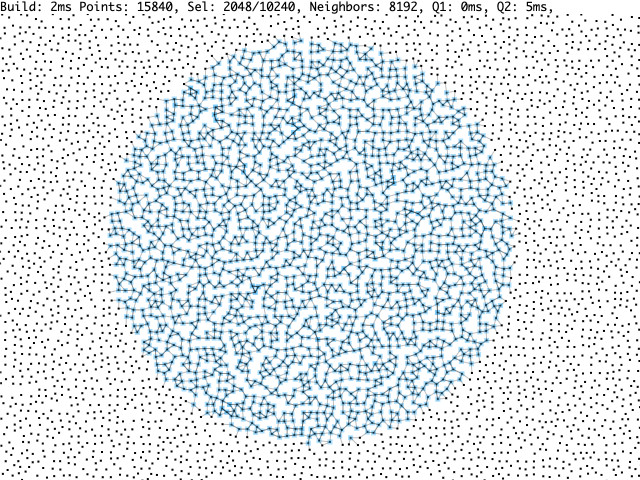
Security News
38% of CISOs Fear They’re Not Moving Fast Enough on AI
CISOs are racing to adopt AI for cybersecurity, but hurdles in budgets and governance may leave some falling behind in the fight against cyber threats.
@thi.ng/distance
Advanced tools
N-dimensional distance metrics & K-nearest neighborhoods for point queries

[!NOTE] This is one of 201 standalone projects, maintained as part of the @thi.ng/umbrella monorepo and anti-framework.
🚀 Please help me to work full-time on these projects by sponsoring me on GitHub. Thank you! ❤️
N-dimensional distance metrics & K-nearest neighborhoods for point queries.
The package provides the
IDistance
interface for custom distance metric implementations & conversions from/to raw
distance values. The following preset metrics are provided too:
| Preset | Number | nD | 2D | 3D | Comments |
|---|---|---|---|---|---|
EUCLEDIAN | ✅ | Eucledian distance | |||
EUCLEDIAN1 | ✅ | ||||
EUCLEDIAN2 | ✅ | ||||
EUCLEDIAN3 | ✅ | ||||
HAVERSINE_LATLON | ✅ | Great-circle distance for lat/lon geo locations | |||
HAVERSINE_LONLAT | ✅ | Great-circle distance for lon/lat geo locations | |||
DIST_SQ | ✅ | Squared dist (avoids Math.sqrt) | |||
DIST_SQ1 | ✅ | ||||
DIST_SQ2 | ✅ | ||||
DIST_SQ3 | ✅ | ||||
defManhattan(n) | ✅ | Manhattan distance | |||
MANHATTAN2 | ✅ | ||||
MANHATTAN3 | ✅ |
Neighborhoods can be used to select n-D spatial items around a given target
location and an optional catchment radius (infinite by default). Neighborhoods
also use one of the given distance metrics and implement the widely used
IDeref
interface to obtain the final query results.
Custom neighborhood selections can be defined via the
INeighborhood
interface. Currently, there are two different implementations available, each
providing several factory functions to instantiate and provide defaults for
different dimensions. See documentation and examples below.
An INeighborhood implementation for nearest neighbor queries around a given
target location, initial query radius and IDistance metric to determine
proximity.
An INeighborhood implementation for K-nearest neighbor queries around a given
target location, initial query radius and IDistance metric to determine
proximity. The K-nearest neighbors will be accumulated via an internal
heap and
results can be optionally returned in order of proximity (via .deref() or
.values()). For K=1 it will be more efficient to use Nearest to avoid the
additional overhead.
An unbounded and unsorted version of KNearest, selecting all
items around the target location and given search radius. Qualifying neighbors
will be accumulated in order of processing via an internal array.
STABLE - used in production
Search or submit any issues for this package
Work is underway integrating this approach into the spatial indexing data structures provided by the @thi.ng/geom-accel package.
yarn add @thi.ng/distance
ESM import:
import * as dist from "@thi.ng/distance";
Browser ESM import:
<script type="module" src="https://esm.run/@thi.ng/distance"></script>
For Node.js REPL:
const dist = await import("@thi.ng/distance");
Package sizes (brotli'd, pre-treeshake): ESM: 1.37 KB
Note: @thi.ng/api is in most cases a type-only import (not used at runtime)
One project in this repo's /examples directory is using this package:
| Screenshot | Description | Live demo | Source |
|---|---|---|---|
 | K-nearest neighbor search in an hash grid | Demo | Source |
import * as d from "@thi.ng/distance";
const items = { a: 5, b: 16, c: 9.5, d: 2, e: 12 };
// collect the 3 nearest numbers for target=10 and using
// infinite selection radius and squared distance metric (defaults)
const k = d.knearestN(10, 3);
// consider each item for inclusion
Object.entries(items).forEach(([id, x]) => k.consider(x, id));
// retrieve result tuples of [distance, value]
k.deref()
// [ [ 25, 'a' ], [ 4, 'e' ], [ 0.25, 'c' ] ]
// result values only
k.values()
// [ 'a', 'e', 'c' ]
// neighborhood around 10, K=3 w/ max radius 5
// also use Eucledian distance and sort results by proximity
const k2 = d.knearestN(10, 3, 5, d.EUCLEDIAN1, true);
Object.entries(items).forEach(([id, x]) => k2.consider(x, id));
k2.deref()
// [ [ 0.5, 'c' ], [ 2, 'e' ], [ 5, 'a' ] ]
If this project contributes to an academic publication, please cite it as:
@misc{thing-distance,
title = "@thi.ng/distance",
author = "Karsten Schmidt",
note = "https://thi.ng/distance",
year = 2021
}
© 2021 - 2025 Karsten Schmidt // Apache License 2.0
FAQs
N-dimensional distance metrics & K-nearest neighborhoods for point queries
We found that @thi.ng/distance demonstrated a healthy version release cadence and project activity because the last version was released less than a year ago. It has 1 open source maintainer collaborating on the project.
Did you know?

Socket for GitHub automatically highlights issues in each pull request and monitors the health of all your open source dependencies. Discover the contents of your packages and block harmful activity before you install or update your dependencies.

Security News
CISOs are racing to adopt AI for cybersecurity, but hurdles in budgets and governance may leave some falling behind in the fight against cyber threats.

Research
Security News
Socket researchers uncovered a backdoored typosquat of BoltDB in the Go ecosystem, exploiting Go Module Proxy caching to persist undetected for years.

Security News
Company News
Socket is joining TC54 to help develop standards for software supply chain security, contributing to the evolution of SBOMs, CycloneDX, and Package URL specifications.